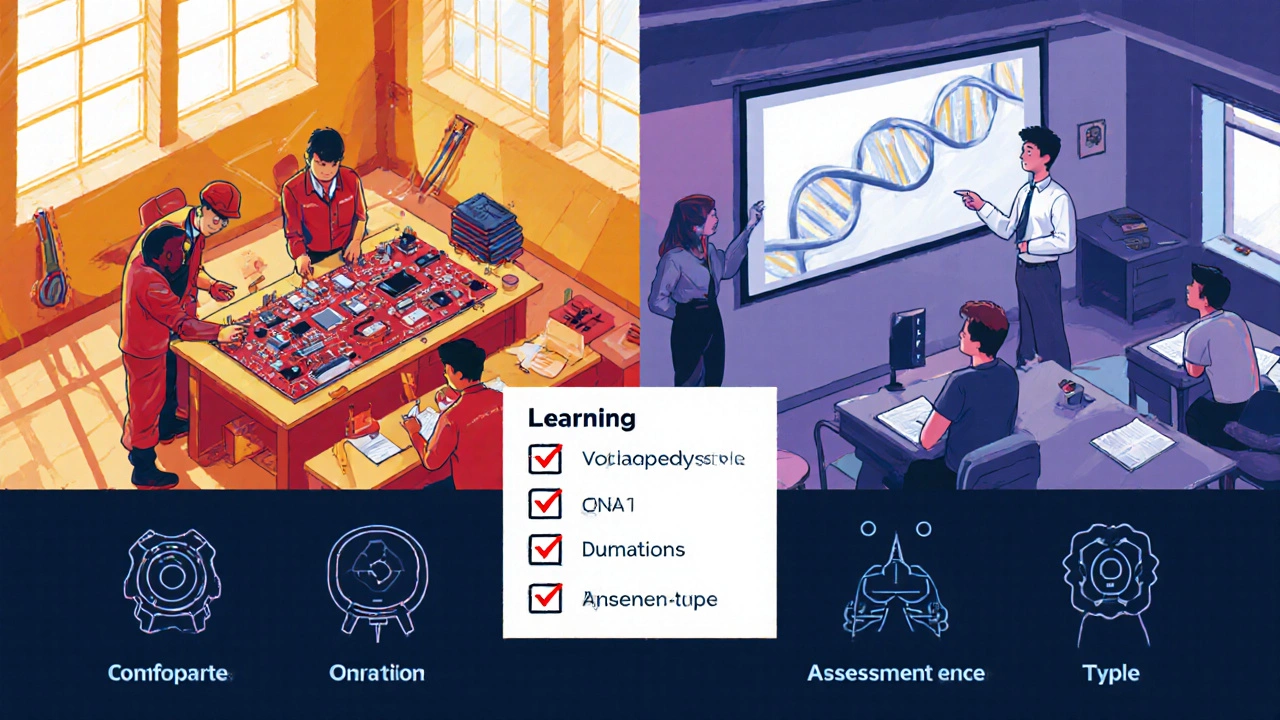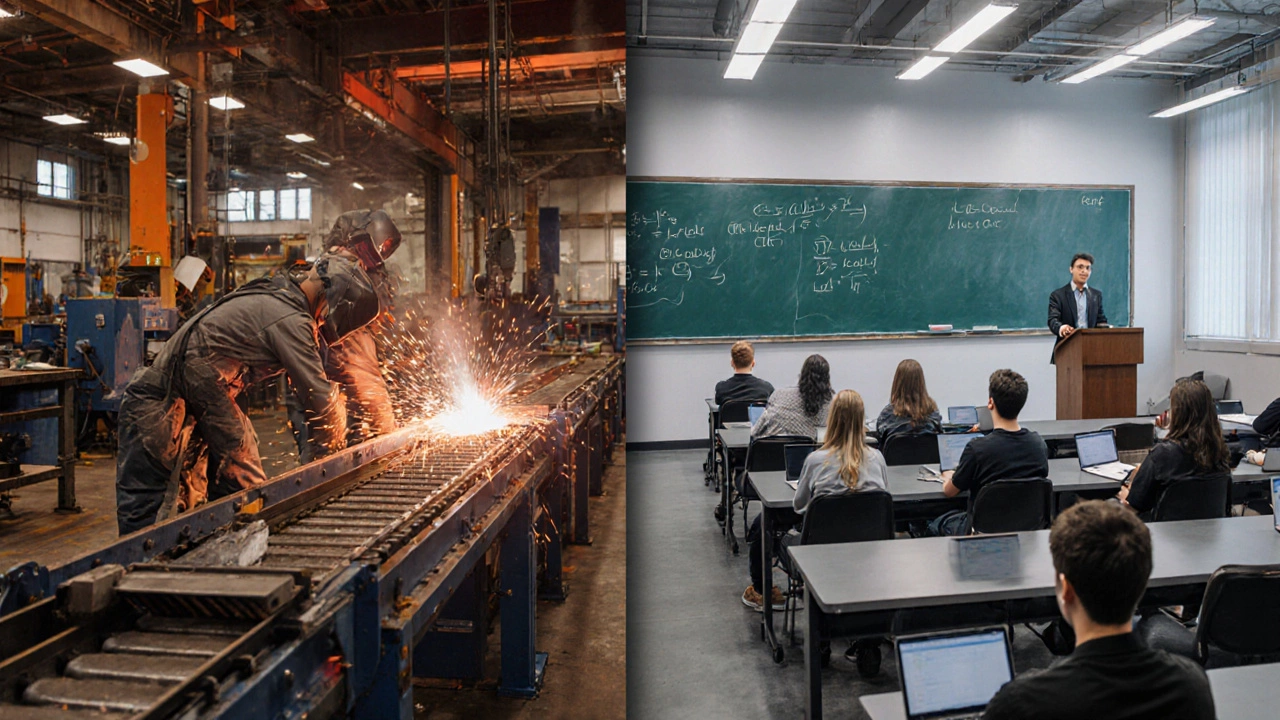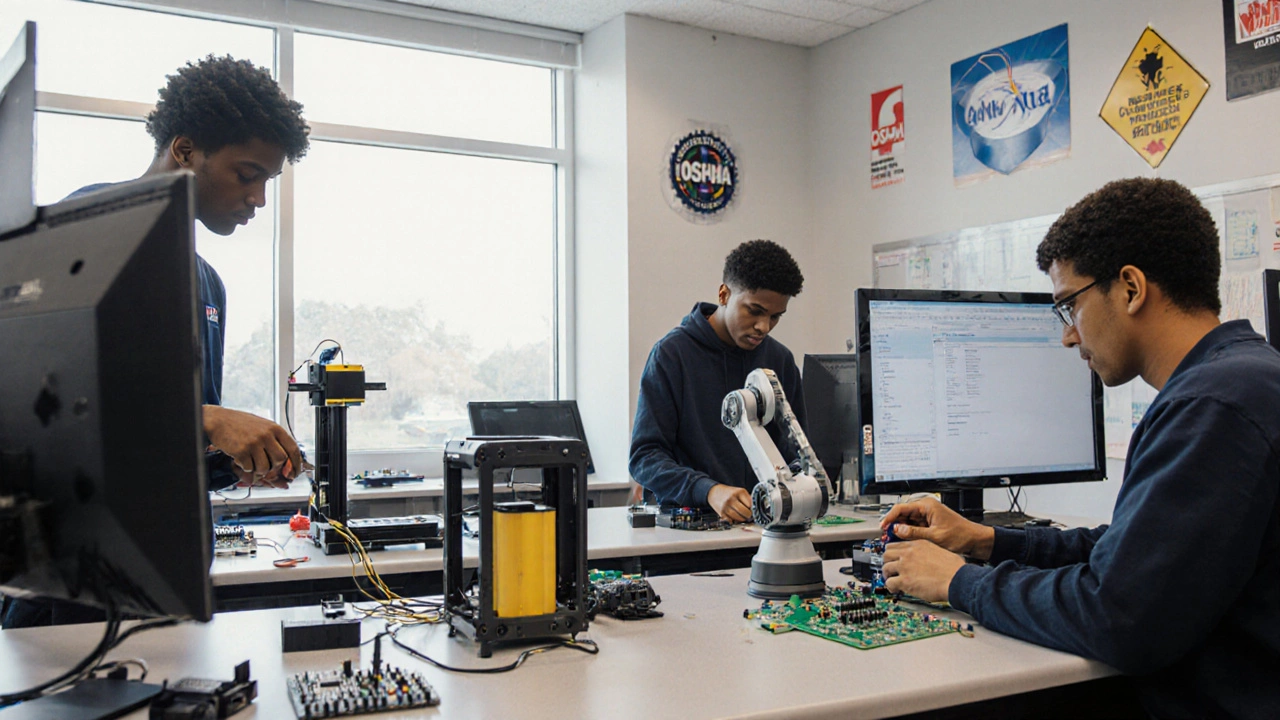Vocational vs. Academic Education Decision Tool
Focused on practical skills for specific jobs. Usually takes 1-3 years to complete.
- Hands-on learning and real-world projects
- Industry certifications and diplomas
- Direct entry into workforce
- Often shorter duration
Emphasizes theoretical knowledge and research. Typically 3-4 years for undergraduate degrees.
- Lecture-based learning and research
- Bachelor's, Master's, or Doctoral degrees
- Broader career flexibility
- Opportunities for advanced study
Answer the following questions to find which path suits you better:
Recommended Path
When you hear the words "vocational" and "academic," you might picture a trade workshop on one side and a lecture hall on the other. Both are called "education," yet they guide you down very different routes. This guide breaks down what each path actually means, how they stack up against each other, and which one might fit your goals.
Key Takeaways
- Vocational education focuses on job‑ready skills and often leads to a diploma or certification within 1‑3 years.
- Academic education emphasizes theoretical knowledge, typically culminating in a degree after 3‑4 years.
- Career earnings can start higher for vocational graduates in trades, while academic grads may have broader long‑term options.
- Both routes can lead to university study; many universities now accept vocational credentials for credit.
- Choosing a path depends on your learning style, career timeline, and the kind of work you enjoy.
Vocational education is a type of structured learning that prepares learners for specific occupations by teaching practical skills and industry‑standard techniques. Programs are often delivered by trade schools, community colleges, or through apprenticeships, and they usually award a diploma, certificate, or associate degree.
In contrast, academic education covers broader scholarly subjects such as sciences, humanities, and social studies, typically delivered in universities or secondary schools and leads to qualifications like bachelor's, master's, or doctoral degrees.
How Each Path Is Structured
Understanding the day‑to‑day structure helps you picture what life will look like as a student.
- Curriculum Focus: Vocational programs center on hands‑on labs, workshops, and real‑world projects. Academic programs lean heavily on lectures, essays, and exams.
- Teaching Methods: In vocational settings, instructors act more like mentors guiding you through tools and equipment. In academic settings, professors often act as researchers sharing theories.
- Assessment: Practical demonstrations, certifications, and industry tests dominate vocational assessments. Academic assessments include papers, midterms, and final exams.

Typical Credentials and Their Value
Below is a side‑by‑side look at the most common credentials you’ll earn in each stream.
| Attribute | Vocational | Academic |
|---|---|---|
| Typical Duration | 1‑3 years | 3‑4 years (undergrad) |
| Common Credential | Diploma, Certificate, Associate Degree | Bachelor's Degree |
| Focus Area | Skill‑based learning (e.g., welding, plumbing, IT support) | Theoretical foundations and research skills |
| Entry Requirements | High school diploma or equivalent; sometimes aptitude tests | High school diploma with minimum grades; often standardized test scores |
| Average Starting Salary (Australia 2025) | AU$55,000 - AU$70,000 | AU$60,000 - AU$75,000 |
| Career Progression | Clear ladder within trade (apprentice → journeyman → master) | Broader options - can move into management, research, or switch fields with further study |
Real‑World Examples
Seeing the concepts in action makes the difference crystal clear.
- John, 22, electrician: After a two‑year Apprenticeship program combining on‑the‑job training with classroom instruction, he earned a certificate and started earning AU$68,000. He plans to become a licensed contractor within five years.
- Sara, 19, biology major: She enrolled in a three‑year Bachelor's Degree in Biological Sciences. After graduating, she pursued a master's and now works as a research analyst, earning AU$85,000.
- Mike, 30, IT support: He completed a six‑month Certificate in Network Administration at a community college. He quickly moved into a junior network engineer role, boosting his salary by 25%.
Which Path Suits You? Decision Checklist
Use this quick checklist to see which route aligns with your goals.
- Do you prefer learning by doing, with immediate hands‑on practice? → Lean vocational.
- Is a broader academic foundation important for you, perhaps for future research or teaching? → Lean academic.
- How long are you willing to study before entering the workforce?
- Shorter (1‑2 years) = vocational.
- Longer (3+ years) = academic.
- Are you aiming for a profession that requires a licensure or trade certification? → Vocational.
- Do you plan to pursue postgraduate study or a career in fields like law, medicine, or academia? → Academic.

How to Get Started
Once you’ve decided, follow these steps to begin your journey.
- Research Local Providers: Look for Trade Schools or community colleges for vocational tracks, and universities for academic tracks. In Sydney, TAFE NSW offers many accredited vocational courses.
- Check Admission Requirements: Gather transcripts, any required test scores, and, for apprenticeships, a resume highlighting any relevant experience.
- Apply for Financial Aid: Both pathways offer government subsidies, such as Australia’s JobTrainer program for vocational learners and HECS‑HELP for university students.
- Enroll and Attend Orientation: Use the orientation to meet instructors, understand the learning platform, and set up any necessary equipment.
- Plan Your Career Path: Talk to school counselors about industry connections, internship opportunities, or further study options.
Future Trends: Blurring the Lines
By 2025, the gap between vocational and academic education is narrowing. Many universities now embed micro‑credentials and industry‑partnered labs that feel very vocational, while trade schools introduce more theory to help graduates adapt to rapid tech changes. Look out for hybrid programs that award both a diploma and some university credits - a sweet spot for those who want practical skills without sacrificing academic credibility.
Frequently Asked Questions
What is the main difference between a vocational diploma and an academic degree?
A vocational diploma focuses on hands‑on skills for a specific job and usually takes 1‑3 years, while an academic degree provides broader theoretical knowledge over 3‑4 years and opens up a wider range of career options.
Can I transition from a vocational program to a university degree?
Yes. Many Australian universities accept vocational credits through articulation agreements. For example, a TAFE diploma in graphic design can count toward a Bachelor of Design.
Which path typically leads to higher starting salaries?
It varies by industry. Trades like plumbing or electrical work often start with salaries comparable to or higher than many bachelor‑degree graduates, especially in regions with strong demand for skilled labor.
Do vocational courses require a lot of homework?
Instead of traditional homework, vocational courses usually assign projects, practical assessments, and industry placements that mimic real work environments.
What are the best resources to decide between the two?
Start with government portals like the Australian Skills Quality Authority for vocational options, and the Department of Education for university courses. Career counselors can also provide personalised guidance based on your strengths.








0 Comments